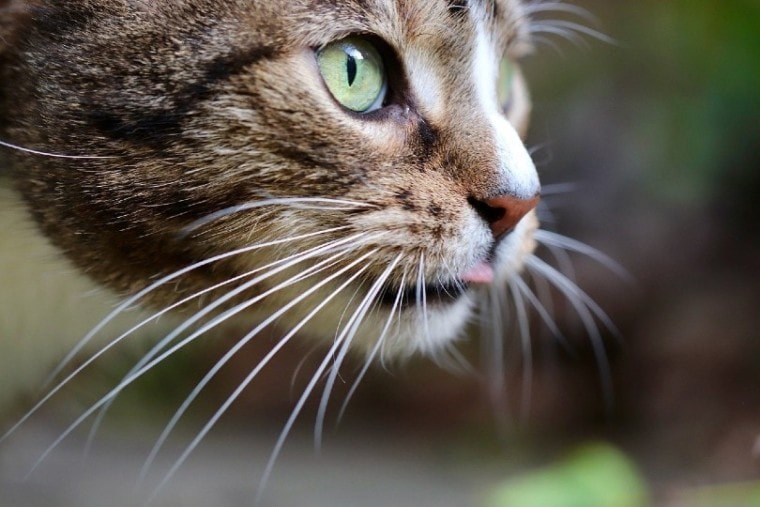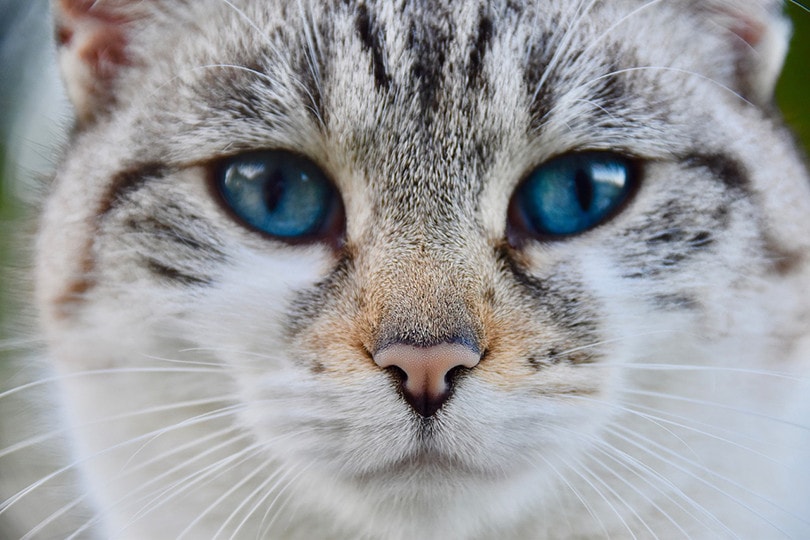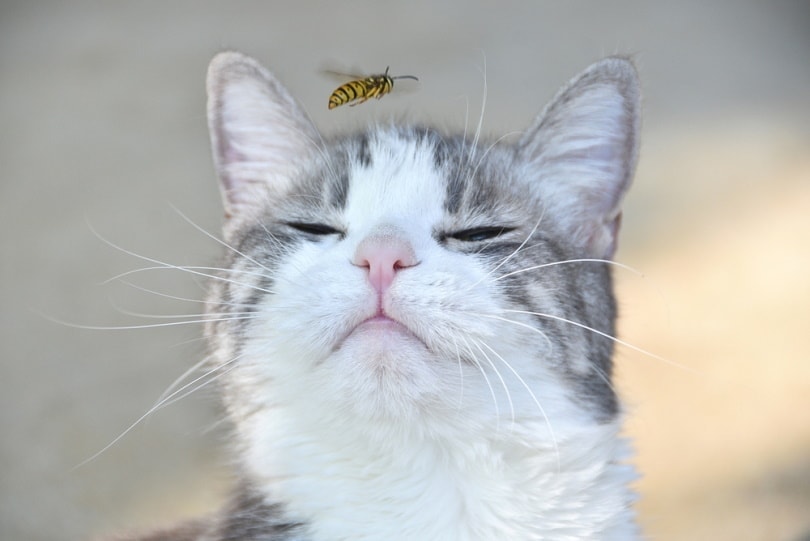
Almost all mammals have whiskers — these are sensory tactile hairs, also known as vibrissae. Only humans and a few other species do not have it. But maybe the first animal that comes to your mind when you think of whiskers is, of course, your dear kitty. So, other than prettifying their angelic faces, why exactly do cats have whiskers?
Cat whiskers are essentially their internal GPS. This built-in radar system allows them to receive and interpret very subtle signals from the world around them. This is, for example, how they can get their bearings in the dark, or how they can judge distances and not break their legs when jumping from a high point. In a nutshell: cat whiskers primarily have sensory functions and help them navigate the world.
What Are Cat’s Whiskers Made Of?
While not technically hair, cats’ whiskers are made of a fibrous protein called keratin, which is also found in hair, nails, and feathers. They are also surrounded by nerves. Besides, the tip of a mustache has a proprioceptor, a sensory receptor that picks up vibrations and environmental changes. This is, among other things, what gives your cat the ability to find his way between your house and his favorite hunting spot in the wooded area of your backyard!

Where Are the Cat’s Whiskers Located?
The question seems trivial and yet the whiskers are not only on the muzzle of your cat! Indeed, they are implanted in several other places: above the eyes, under the chin, and on the back of the legs. There are eight to twelve vibrissae on each side of the nose, not counting those on the rest of the body. Sensory organs par excellence, they act as a sixth sense for cats and reinforce their other five senses, already very sharp, in everyday life.
What Are the Essential Functions of Whiskers?
Your cat’s whiskers have many functions, but first and foremost are sense organs. Also known as vibrissae, from the Latin word “vibrio” meaning “to vibrate,” mustaches do transmit vibrations.
Indeed, one of the main functions of vibrissae is to help the cat find his way around his environment: they greatly improve his perception of the world and allow him certain feats such as calculating when he must turn around during a fall to fall back on his feet. They also assist him when hunting and help him orientate himself in space by detecting obstacles. Whiskers can transmit this information directly to the brain and allow cats to detect minute changes, allowing felines to effectively adjust their trajectory.
Moreover, the cat has the reputation of being able to squeeze through surprising interstices, especially under furniture or in openings, even in the dark. It is by touching the obstacles that the whiskers indicate to the cat the space available so that it can pass without bumping into the door frame, hence their usefulness to be dispersed in several places of the body.
Whiskers also perceive changes in the atmosphere and wind direction to help the cat hide its own scent during the hunt and locate that of its prey. They also act as emotional and social barometers.
More Details on the Functions of a Cat’s Whiskers:

1. Whiskers are a built-in tape measure that allows cats to gauge the width of spaces.
Have you ever seen your cat poke its head somewhere before entering it? It’s his way of judging if he fits in this space.
Indeed, through the whiskers, the cat feels the variations of the air around him by perceiving the forces of friction. They will thus help him to detect the moving and immobile obstacles which are around him and on his trajectory. Thanks to that, he avoids bumping into them and can measure the width of a passage without resorting to sight. By capturing waves of movement, vibrissae allow it to hunt even in the dark since they help to locate prey by strengthening its hearing and smell.
2. Whiskers help cats to communicate.
The vibrissae of the cat are also an indicator of mood and emotions that are used to communicate with its congeners. Thus, they have an essential function in feline body language and, therefore, in social exchanges. It is possible to guess your cat’s moods by observing his whiskers: if he is worried or frightened, he will bring them back, conversely, he will keep them pointed forward when he is curious, sure of himself, aggressive, or when he wants to get to know one of his peers. This is how the vibrissae allow cats to greet each other and to announce their intentions to each other. They, of course, complement the rest of the body language: position, postures, wearing the tail and ears, etc. Finally, a relaxed feline holds its loose, drooping whiskers to the sides.
3. Whiskers support cats’ vision.
You probably didn’t know it, but your cat can’t see up close. If an object is one foot or less from its eyes, your cat relies on its whiskers to determine its location, size, and texture. These are therefore essential when wandering around in the dark.
Indeed, a cat can wander around in the dark without bumping into anything. He owes this incredible talent to his whiskers, which detect the air currents in the room based on factors such as the arrangement of furniture, and then transmit that information to the brain.

4. Whiskers are a defense mechanism.
Cat’s whiskers also serve to protect sensitive areas of their body. For example, the ones around his eyes can signal him to close his eyes quickly before debris (even tiny dust particles) enter them. They can also detect sharp objects, helping your cat avoid injuring their face or eyes.
What Happens If You Cut Your Cat’s Whiskers?
As you can see, whiskers are not a trivial organ for your feline companion. If you cut them off, they will, fortunately, grow back but it will take some time during which he will be handicapped in his movements and will not be able to communicate correctly with his peers. But like the rest of his hairs, they fall off and renew themselves naturally throughout the year.
Tip: Many cats don’t like to drink and eat from certain bowls because their whiskers touch the sides, causing them physical discomfort due to the sensory nerves surrounding their whiskers. This is called whisker fatigue. You can remedy this situation by simply purchasing wider and deeper bowls.
Final Thoughts
The whiskers of cats are an integral part of their anatomy and perform essential functions: they are mainly used for orientation, communication, and the cat’s sense of touch. Without them, cats would surely lose their elegant gait, bumping into any object in their path!
Related Read:
- Do All Cats Have Whiskers? Anatomy Explained
- Do Cats Actually Have Whiskers on Their Legs? Feline Anatomy Revealed
Featured Image Credit: Annette Meyer, Pixabay







